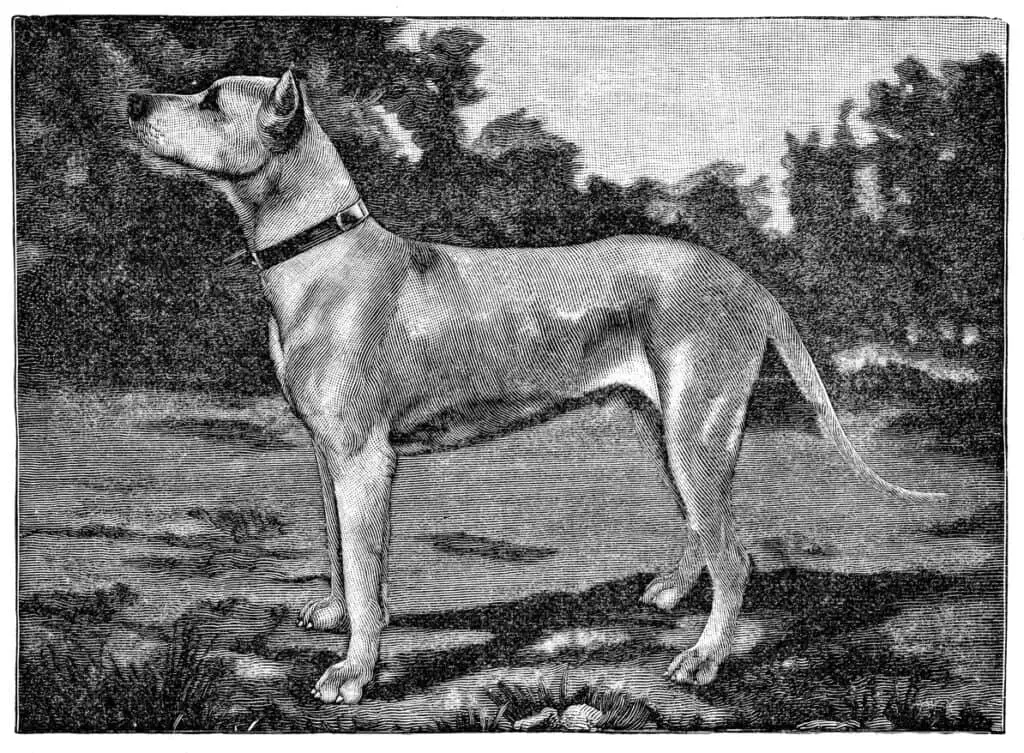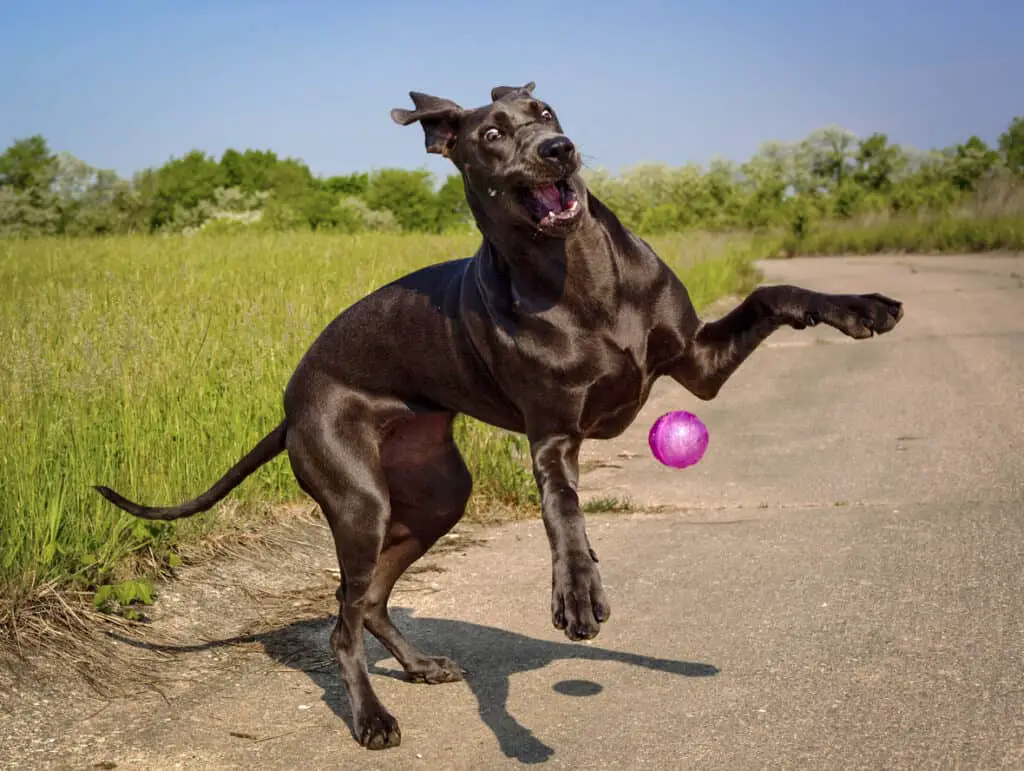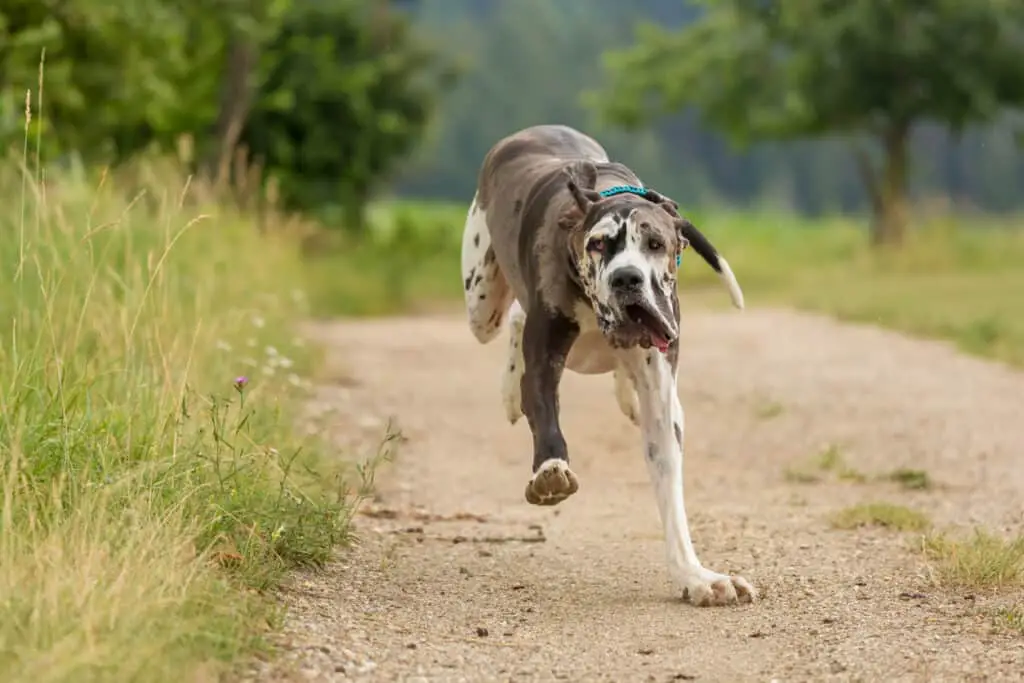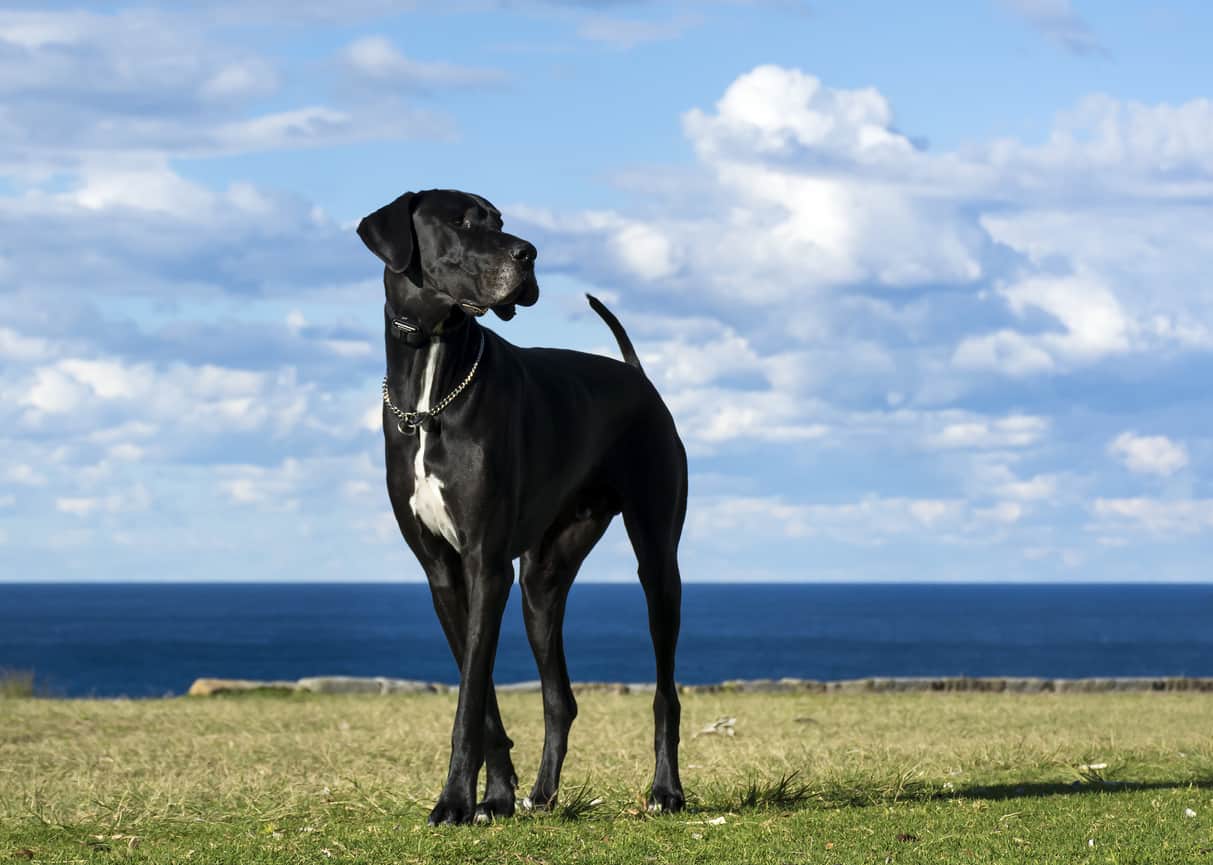Contrary to their name, the history of the Great Dane begins in Germany, not Denmark as their name would imply. The name of the Great Dane in German is the Deutsche Dogge, meaning German Mastiff. A common story explaining the change in the dog’s name is that a French naturalist traveled to Denmark and took a great interest in the Great Danes he saw there. He is reported to have brought a Great Dane back to France and proclaimed it a “Grand Danois.” (This just goes to show, it’s important to trace the story to its origins!) Today, Great Danes are known in Germany, France, and Canada as the Dogue Allemand, meaning German dog.

Although their origins have been traced beyond their Germanic roots, these gentle giants are best known for their role as boar hunters. At that time, they displayed all of the eagerness to please their masters, but little of the docility they are known for today. This is due to the nature of their work – hunting required obedience, adaptability, and great courage. In fact, boar catcher is the more appropriate term for their historic role, as these enormous dogs were used to chase down and hold the boar so that the humans could finish it off upon arrival. Their lithe bodies and long legs gave them an advantage when bounding after fleeing boards, and their loyalty and dedication to their masters was recognized as an excellent quality for guarding. Over time Great Danes came to assume to role of guard dogs for German nobility.
As the breed evolved, it is believed that English Mastiffs and Irish Wolfhounds were mixed into the breed, contributing to the tall, sleek, and imposing Great Dane we know and love today.

The modern Great Dane is one of the tallest breeds in the world. It began to appear in the United States in the late 19th century and was formally recognized by The American Kennel Club (AKC) in 1887. Today, it is one of 199 breeds they have recognized.
Breed recognition by the American Club is a complex process involving the careful tracking of multiple generations of the breed pending recognition. This tracking eventually culminates in the designation of a breed “parent club” that functions as the official breed description. This description is the blueprint against which both breeders and judges measure the quality of the breed and elucidates the breed standard, such as acceptable height, weight, colors, and other distinguishing features.
In the case of the Great Dane, the breed standard as determined by the AKC defines a Great Dane first and foremost as a breed that “combines, in its regal appearance, dignity, strength and elegance with great size and a powerful, well-formed, smoothly muscled body.” It is classified as a giant working breed and known to be friendly, dependable, and loyal. Males are expected to be a minimum of 30 inches at the shoulder, with the typical range being 30-32 inches and greater height being preferred. For females, that range is 28-30 inches, and, like males, greater height is appreciated.
Historically, Great Danes have topped the Guinness Book of World Record’s list in the Tallest Dog category. The most recent winner of the accolade was Freddy, who stood 40 inches high at the shoulder and held the coveted title until 2021, when he passed away at 8.5 years of age. The all-time world record holder was a Great Dane named Zeus from Michigan, who dwarfed Freddy by standing 44 inches at the shoulder. Unfortunately, the great Zeus passed away at just five years of age. Although Zeus’ owners publicly stated that he passed away due to natural causes associated with old age, it’s likely that he passed away from one of the maladies that have historically afflicted this giant breed. Although Great Danes have shorter lifespans than many smaller breeds, Zeus’ death occurred nearly two years prior to the expected range of 7-10 years. This is not to imply in any way that Zeus’ death was not natural, but rather, a suggestion that his slightly early passing could be indicative of the fact that when a chief breed characteristic (height) is exacerbated, it can lead to a greater likelihood of affliction by health issues already associated with that characteristic.

The health issues that dog this enormous animal tend to derive directly from their defining characteristic: their size. More specifically, their height is a health liability due to the fragility of their skeletal build. Unlike more robust dogs, the Great Dane has a deep, narrow chest and a lean frame. As puppies, they experience an extended growth phase that typically results in the puppy gaining over 100 pounds in its first year of life. Owners need to educate themselves on how to properly support this growth in order to invest in the long-term health of the dog.
This education is particularly important for owners who bring the Great Dane into a family setting. While Great Danes have temperaments that are wonderfully compatible with a family setting (they are even affectionately known as “nanny dogs”), a natural temperament still needs to be shaped into a learned obedience.
Great Danes are quite trainable and considered about average intelligence overall. The standard typically referenced when learning about a breed’s intelligence and trainability was created by a renowned professof of canine psychology, Dr. Stanley Coren. In his 1994 book, The Intelligence of Dogs, he details research conducted in partnership with 208 obedience trial judges from the Canadian Kennel Club and the American Kennel Club (AKC) to develop criteria for dog intelligence. In this ranking, which has been updated since its initial publication, the Great Dane ties for 48th with the Boxer out of 130 breeds tested on the list, landing them squarely at the bottom of the top 35th percentile. They can be stubborn and require patience and repetition, on average learning new commands with 25-40 repetitions. However, the breed is considered above average in an area known as adaptive intelligence.
Adaptive intelligence refers to the ability to appropriately modify behavior based on circumstance. The Great Dane’s above-average adaptive intelligence can likely be attributed to their historic use as boar chasers – participating in a hunt required the ability to make decisions based on rapidly changing circumstances, which were often very dangerous, too. Today, because the breed has been infused with dependability, loyalty, and patience, they are known to make excellent mobility service dogs.
While the role of a mobility service dog may seem straightforward (to assist those whose mobility is limited), it is actually an excellent example of a role suited for an animal with high adaptive intelligence. For example, the reaction to someone who falls while at home in their kitchen will necessarily be different than the reaction to someone who stumbles and falls in an intersection while crossing the street. While the Great Dane will not be able to know why the situations are different in their urgency and the reactions required, their natural ability to recognize situational differences make them ideal service dogs for situations requiring a little more nuance.
High adaptive intelligence also manifests as sensitivity in Great Danes, which is important for owners to remember when the Great Dane is in training. Great Danes are extremely responsive to the tone and volume of a verbal command or correction, meaning that owners should take care to regulate their tone and adopt a consistent one when in training “mode” with their Great Dane. Additionally, while no dog should ever be physically struck or harmed during training, this approach can be particularly detrimental to Great Danes due to their tendency to become skittish or ornery when mistreated (in fact, their stubbornness is quite legendary).
Given the fact that a full-size Great Dane is larger than most humans and far stronger, a harsh approach to training is guaranteed to erode the bond between owner and dog over time, resulting in a distrustful dog that feels it has no one to look to for reassurance or guidance. This result is particularly detrimental to Great Danes, who crave novel stimuli but also need to be confidently and gently led through new experiences. A Great Dane that lacks trust in its leader will naturally lack confidence in itself, causing it to revert to distrustful reactions when faced with new situations. This can easily become an unhealthy and even dangerous pattern.
If you want to set your Great Dane up for success and raise an intelligent and well-adjusted animal, the most important factors that will influence your Dane’s trainability are socialization and obedience training. The best way to facilitate these aspects is to bear in mind the history of the Great Dane when designing activities that you want to be stimulating and interesting to your Great Dane. For example, many Great Danes adore frisbee because it triggers their natural urge to run after (“hunt”) something, and you can train them to bring the frisbee back to you.
When designing situations to increase the socialization of your Great Dane, you will likely be focusing on the quality and appropriateness of their interactions with others. While the Great Dane’s loyalty and protectiveness is an excellent quality to have in a guard dog, introducing them to other situations that may trigger their protectiveness but result in them learning that something is not actually a threat (such as taking them to visit your friend and then allowing your friend to give you a big bear hug hello). Socializing them with other dogs is equally important so that they learn how to appropriately interact with other dogs you may encounter at dog parks, on walks, or at the veterinarian.
Ultimately, learning about the history of the Great Dane is a useful way to learn many things about the breed. It can help you learn about your compatibility with the breed, or it can help you understand your Great Dane better. This knowledge is valuable because being a dog owner is all about learning how to be a reliable canine leader for your beloved pet. Great Danes require respect and fair treatment, and thrive when the rules and expectations that govern their behavior are clear. A Great Dane’s size makes it more important for owners to invest in the resources necessary to raise a well-mannered dog because their size can quickly become a liability risk. Great Danes tend to be unaware of their size until they realize they can use it to their advantage, such on walks, jumping up, and leaning. This innocent obliviousness is helpful when training, but can quickly become difficult to correct if the Great Dane is not provided with the appropriate training structure. More often than not, the best training structure is one that takes into account the history of a breed so as to draw out their natural inclinations and set them up for success as the gentle giants they’re renowned for being.


